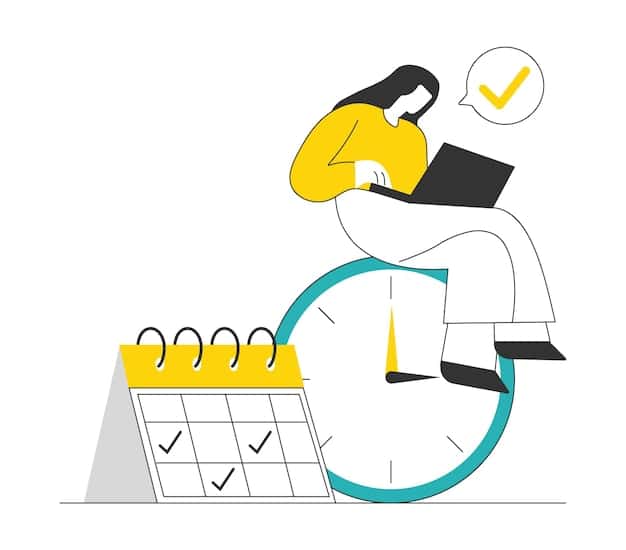Parkinson’s Law: Reclaim Your Time & Boost Productivity by 15%

Parkinson’s Law states that work expands to fill the time available for its completion, often leading to wasted time; strategies to shrink task completion times include setting strict deadlines, breaking down tasks, and focusing on high-priority activities to boost productivity by 15%.
Are you struggling to complete tasks efficiently? Is Parkinson’s Law Sabotaging Your Time? Strategies to Shrink Task Completion Times by 15% is crucial; this principle explains why tasks often take longer than necessary. Understanding and combating Parkinson’s Law can significantly boost your productivity and help you reclaim your time.
What is Parkinson’s Law?
Parkinson’s Law, coined by Cyril Northcote Parkinson, is the adage that “work expands so as to fill the time available for its completion.” In simpler terms, if you give yourself a week to complete a task, it will likely take the entire week, even if the task could be done in a day or two.
This isn’t just about laziness; it’s a psychological phenomenon. The more time we have, the more complex we make the task, adding layers of perfectionism and unnecessary details.
The Psychology Behind Parkinson’s Law
Several factors contribute to why Parkinson’s Law affects us: the fear of idleness, procrastination, and the tendency to seek perfection. When we have ample time, we tend to delay starting the task, leading to a last-minute rush. Furthermore, the extra time allows for overthinking, causing us to refine and tweak the task needlessly.
Real-Life Examples of Parkinson’s Law
Consider a student given two weeks to write an essay. They might spend the first week procrastinating and only begin writing in the final days, filling that time with research and edits that could have been done sooner, ultimately delivering the essay right before the deadline. Or think of a project at work with a long timeframe; meetings drag on, approvals take longer, and the project becomes more complicated than necessary, all because there’s plenty of time to spare.

In essence, Parkinson’s Law isn’t about time management; it’s about managing your perception of time. By understanding this phenomenon, you can start implementing strategies to regain control of your schedule and improve your efficiency.
Why Does Parkinson’s Law Hurt Productivity?
Parkinson’s Law can significantly hurt productivity by stretching out tasks unnecessarily and consuming valuable time that could be allocated to other important activities. Understanding its impact is critical for improving efficiency.
The core issue is that Parkinson’s Law causes tasks to become more complex and time-consuming than they need to be. When people have more time, they tend to:
- Procrastinate: Delaying the start of a task often increases stress and reduces the overall quality of work.
- Overcomplicate: Adding unnecessary details and refinements can divert focus from the core objectives.
- Waste Resources: Prolonged tasks consume more resources, including time, energy, and possibly finances.
All these symptoms directly relate to lowered productivity. Here is a more detailed overview:
Missed Opportunities
When tasks take longer than they should, you miss opportunities to work on other important projects. This can lead to a backlog of tasks and increased stress levels. For example, spending an entire week on a presentation that could have been completed in three days means you lose four days that could have been used for strategic planning or other high-value activities.
Increased Stress and Burnout
The pressure of looming deadlines, coupled with the frustration of tasks dragging on, can lead to increased stress and burnout. Constant multitasking and the mental load of managing prolonged projects can take a toll on mental and physical health. Studies have shown that stress reduces productivity by impairing focus and decision-making abilities.
The Cost of Inefficiency
Inefficiency caused by Parkinson’s Law can have significant financial implications for businesses. Projects that take longer to complete incur higher labor costs and delay revenue generation. Moreover, the cumulative effect of individual inefficiencies across an organization can result in substantial financial losses over time.
Effective Strategies to Overcome Parkinson’s Law
Overcoming Parkinson’s Law requires a conscious effort to restructure how you approach tasks and manage your time. Here are some effective strategies to prevent work from expanding to fill available time:
These strategies are actionable and can be tailored to suit various tasks and work environments.
Set Realistic Deadlines
One of the most effective ways to combat Parkinson’s Law is to set realistic deadlines. Break down larger tasks into smaller, manageable segments, and assign a specific timeframe to each. Make these deadlines challenging but achievable.
Prioritize Tasks
Use prioritization techniques like the Eisenhower Matrix (urgent/important) to focus on high-priority tasks first. This ensures that critical work gets done efficiently. By identifying and eliminating non-essential activities, you can streamline your workflow and concentrate on what truly matters, helping you manage your workload much better.
- Time Blocking: Allocate specific blocks of time for specific tasks.
- Eat the Frog: Tackle the most challenging task first thing in the morning.
- The 80/20 Rule: Identify the 20% of tasks that yield 80% of the results.
These techniques can help you create a structured and efficient approach to daily tasks, maximizing output while minimizing wasted time.
How to Set Realistic Deadlines That Work
Setting effective deadlines is crucial to overcoming Parkinson’s Law. However, simply setting a deadline isn’t enough; it needs to be realistic and well-planned to be genuinely effective.
By setting appropriate deadlines, you ensure that tasks are completed efficiently and on time, without sacrificing quality.
Assess the Task Scope
Before setting a deadline, fully understand the scope of the task. Consider all the steps involved, the resources required, and any potential roadblocks. Breaking down the task into smaller parts can help you estimate the time needed for each segment more accurately.
Consider Past Performance
Look back at similar tasks you’ve completed in the past. How long did they take? Use this data as a benchmark for setting your new deadline. If there were challenges during previous tasks, factor those into your time estimate.

Use Time-Tracking Tools
Utilize time-tracking tools to monitor how long tasks actually take. This provides valuable insights into your work habits and helps you refine your deadline-setting process. Tools like Toggl Track or RescueTime can track how you spend your time, providing data that helps you manage tasks more effectively.
By setting smart deadlines, individuals can maximize productivity and diminish the negative implications of Parkinson’s Law.
Tools and Techniques for Efficient Time Management
Effective time management goes beyond just setting deadlines. It involves using the right tools and techniques to streamline your workflow, stay organized, and maximize productivity. Here are some valuable resources to help you manage your time efficiently.
Incorporating these tools and techniques into your workflow can significantly improve your time management skills and help you combat Parkinson’s Law effectively.
Project Management Software
Project management software helps you organize tasks, set deadlines, and track progress. Tools like Asana, Trello, and Monday.com provide features to break down projects into manageable tasks, assign responsibilities, and monitor progress, making it easier to stay on schedule.
Time-Tracking Applications
Time-tracking apps provide real-time data on how you spend your time. Tools like Toggl Track, RescueTime, and Clockify track the time spent on different tasks, providing insights into your work habits and helping you identify areas where you can improve efficiency. This includes:
- Kanban Boards: Visualize workflow and manage tasks in columns representing different stages of progress.
- Gantt Charts: Plan and schedule projects with interconnected tasks and dependencies.
- Time Audits: Periodically review how you spend your time and identify time-wasting activities.
These additional items can help you create a structured and efficient approach to daily tasks, maximizing output while minimizing wasted time.
Creating a Time-Conscious Work Environment
Creating a time-conscious work environment is essential for maximizing productivity and minimizing the impact of Parkinson’s Law. By fostering a culture that values efficiency and focus, you can encourage better time management practices among your team.
A supportive environment reinforces the importance of effective time management.
Encourage Focused Work Sessions
Promote the use of techniques like the Pomodoro Technique, where employees work in focused bursts with short breaks. This can help maintain concentration and prevent burnout. Implement practices such as minimizing distractions during work hours and setting aside “focus time” for critical tasks. This includes:
A workspace free of interuptions where people can sit in silence can be a game changer when it comes to Parkinson’s Law.
- Eliminate Multitasking: Encourage focusing on one task at a time.
- Set Meeting Limits: Keep meetings concise and focused on specific objectives.
- Provide Time Management Training: Offer workshops and resources on effective time management techniques.
These initiatives can help create a structured and efficient approach to daily tasks, maximizing output while minimizing wasted time.
| Key Point | Brief Description |
|---|---|
| ⏱️ Set Deadlines | Establish realistic deadlines to prevent task expansion. |
| ✅ Prioritize Tasks | Focus on high-priority tasks; delegate or eliminate others. |
| 🛠️ Use Tools | Employ time-tracking and project management tools. |
| 🏢Create an environment | Promote focused work sessions and limit distractions. |
Frequently Asked Questions (FAQ)
▼
Parkinson’s Law is the principle that work expands to fill the time available for its completion. In simpler terms, a task will take as long as you allow, whether it needs that time or not.
▼
Break tasks into smaller steps, estimate the time each requires, and add a buffer for unplanned issues. Review past tasks to gauge your typical pace, and consider your energy levels at different times.
▼
There are a plethora of tools, including task managers like Asana or Trello, calendar apps such as Google Calendar, and time-tracking apps like Toggl Track. Find the tools that best fit your usage.
▼
Procrastination exacerbates Parkinson’s Law by causing you to delay starting tasks until the last minute, which results in a frenzied rush. Setting early deadlines will help you avoid the effects of this.
▼
Yes, it absolutely can. Implement project management tools, encourage focused effort, and carefully distribute responsibilities to keep momentum. Regular updates from members will also keep projects moving forward.
Conclusion
By understanding and actively combating Parkinson’s Law, you can unlock new levels of productivity, reduce stress, reclaim valuable time, and boost productivity by at least 15%.





